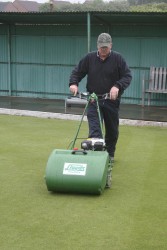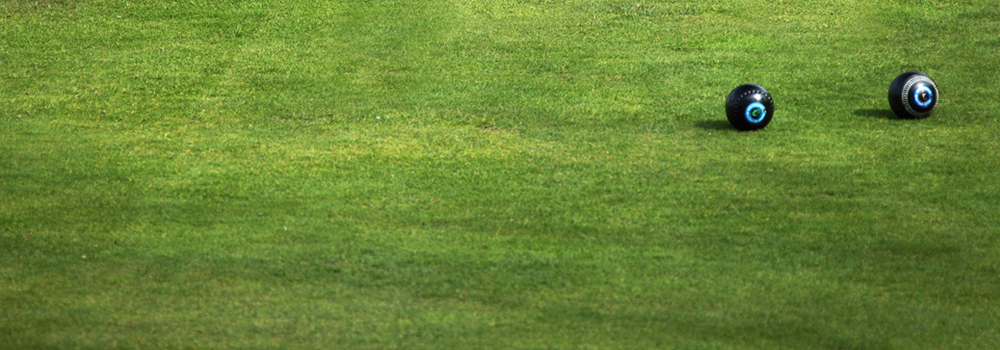
On the Pitchcare Forum, we have had a discussion about the best method of spraying a bowls green. It would appear that some bowlers believe the use of a wheeled pedestrian sprayer creates 'runs' on the green that affect play; not making any allowance for the fact that they are continually walking up and down the green, and are three times heavier than a sprayer - and there are usually four of them! You couldn't make it up.
Also on the Forum is an interesting thread about players who 'bowl from the hip' - with advice on how to deal with them.
Key Tasks for June

There are still too many bowling clubs working with limited resources, often using very antiquated equipment and machinery. Many clubs have mowers that are often twenty plus years old. Nothing wrong with that, if they have been regularly serviced and are fit for purpose (sharp and able to cut to heights of 4-5 mm). For the next month or so, UK growth reaches a peak, therefore the emphasis will be on mowing frequency as long as there is sufficient moisture within the soil.
- Timely operations of feeding, aerating, watering and grooming (verticutting and brushing) are essential for the welfare of the grass plant.
- Power brush or verticut the sward to stand up any persistently straggly grass, this operation also allows for a fresher, cleaner cut.
- A light scarifying of the playing surface every 3-4 weeks can also improve the speed of the green.
- Check areas where dew is not present for signs of stress or dry patch.
- Do not underestimate the importance of watering correctly, ensuring you are watering to a consistent depth and not allow the sward to become too dry and hydrophobic.
Irrigation. Watering is all about understanding the grass plant's needs and knowing your soil profile; sandy soils are more free draining than loamy/clay soils. Watering is all about uniformity. Ideally, you should soak your green (flood it up) and allow it to dry out over a few days .
Mowing will be the key activity, keeping the greens mown at between 4-6mm, so as not to put undue stress on the grass.
Double cut the green in a diamond formation for tournaments and finals. This type of cut removes more grass from the same area without the need to reduce the cutting height.
Fertilising. Most Greenkeepers will be applying a summer N P K fertiliser, perhaps something like a 12:0:9, reducing the N and P inputs, trying to maintain a stable balanced growth during June. You could also look to use a slow release fertiliser that will see you through July and August. The choice of material and how well it works will be dependant on factors such as soil type and weather, with moisture and air temperature being the catalyst for growth.
It is essential to ensure there is enough soil moisture present to activate the fertiliser product used. Liquid feeds are more efficient in getting into the plant, especially when used as a foliar feed.
Seeding. Seeding sparse or bare areas can be continued. The higher soil and air temperatures will help germination. Use germination sheets to aid this process, but remove the sheets regularly to check for diseases.
Topdressing is usually carried out in spring and autumn in conjunction with the renovation programmes. However, some bowling clubs have a policy of applying topdressing materials during the season. It is important that an appropriate material is sourced to ensure compatibility with the existing rootzone materials of your green. The last thing you want to encourage are rootbreaks in the green.




As we head into June, the levels of grass growth should be at a peak for the year. This means a lot of mowing for greenkeepers but, more importantly a greater requirement for essential nutrients. Playing surfaces should be monitored closely for signs of nutrient stress and, allied with soil sample results taken in the spring, fertiliser choices can be made to suit the conditions and type of grass/soil present.
Where areas have been seeded then little and often applications of foliar applied nitrogen combined with liquid humates, seaweed and sugar (carbon) will foster multiple metabolic functions enhancing establishment. Foliar phosphite should also be considered into the routine due to its powerful root stimulating effect.
Established turf areas will no doubt be seeing a flush of growth due to the rainfall, especially where fertilisers applied at the end of March or early April have lain dormant, awaiting activation and availability to coincide with growth. Monitoring plant response and timing additional applications as part of your maintenance plan will continue to be the way forward throughout June.
Proactive, timely applications of biostimulants, such as seaweed, humates and carbon sugars in combination with key essential plant nutritional elements such as; potassium, calcium, phosphite and silicon prior to periods of environmental (abiotic) and pathogen (biotic) stresses, will help to directly prime natural defences in the plant and prime plant defence beneficial microorganisms. Nature is the perfect system, respecting it, understanding it and then using it to our advantage is always wise.
Moisture management could also potentially be a key feature of the month. Now is the time to get ahead of dry patch with a wetting agent – prevention by applying them whilst the soil is still moist is much better than cure on baked hard massively hydrophobic soils.
With increasing restrictions on fungicide active ingredients forecast to come into force over the coming twelve months, each individual responsible for managing sports turf surfaces is going to have to become knowledgeable and competent in the following areas.
- Understanding of contributory underlying agronomic conditions e.g. thatch, species composition
- Disease life cycles
- Disease forecast modelling
- Fungicide mode of action classification
- Utilising specific nutritional and bio-stimulant inputs to elicit specific preventative effects
Together, accumulation of this knowledge can form the basis of a proactive approach which formulates turf disease management as part of an integrated approach. Often you will see this labelled as IPM (Integrated Pest Management), or within our industry ITM (Integrated Turf Management).
Many people have been caught out in 2017 by chafer grub and leatherjacket issues, which could have largely been avoided if a proactive approach to understanding the ins and outs of biological control had been undertaken in the run up to chemical withdrawal. We all need to work together to ensure this is not repeated when it comes to disease management.
Keep an eye on Pitchcare throughout the year as we provide resource materials and opportunities for direct learning at events.
Fair Ring and Dry Patch
Increased activity in soils of certain fungal species may lead to regions of the profile exhibiting hydrophobic behaviour. This is to say water repellency, similar to the manner in which water beads on the surface of a freshly waxed car. This may lead to dry patch or class one fairy ring damage, whereby the inability of water to adhere to the soil particles in these regions results in drought stress, wilt and finally grass dormancy (browning off). If drought conditions within a region of soil persist, then dormancy will be over taken by plant death.
The treatment for both is very similar;
- Identify the depth of the area of repellency by dropping a small amount of water onto a cross profile.
- Poke into the areas of repellency with aeration.
- Soak the areas with water combined with a penetrant wetting agent
Variation on the above occurs with respect to dry patch and hydrophobic activity due to the activity of Basidiomycota spp. fairy rings. In the case of class two fairy rings i.e. dark green rings, a fungicide containing azoxystrobin such as Syngenta’s Heritage Turf Disease Control applied alongside the wetting agent can assist in control.
One word of caution: there are two species of fungi relating to ring like diseases.
- Rhizoctonia spp. – this fungus results in a disease commonly referred to as either Brown Ring or Waitea patch and favours low nitrogen high, thatch conditions in times of moisture and humidity. Generally, it occurs only in the thatch layer.
- Basidiomycota spp. – results in the classic class one, two and three type fairy rings, resulting in various combinations of; hydrophobic soils, flushes of green growth and sporocarps (mushrooms). Generally, it occurs in soil horizon.
The key point here is in relation to water because rings occurring due to Basidiomycota spp. require wetting to relieve symptoms whilst rings occurring due to Rhizoctonia spp. will be made worse by wetting. A case of mistaken identity with these two diseases and, in particular mistaking Rhizonctonia spp. for Basidiomycota spp. which then results in applications of water, will only serve to promote the disease further.
Weed Control
If growth is good and areas are not under drought stress, then June represents a very good time of year for an application of selective herbicide. Ensuring sprayers are well calibrated and nozzles not worn increases efficiency significantly. It is also good practice both in terms of economics and environmental responsibility. An addition of an adjuvant to increase uptake will enhance efficacy and should be considered. As should the use of a pH buffer in areas where your water source exceeds pH 6.4. This is because a water pH above this value increases the vulnerability of pesticides and fertilisers to hydrolysis – the chemical breakdown of a compound due to a reaction with water – increasing the risk of pesticides and fertilisers degrading or precipitating out of solution. This results in poor performance of those products due to the reduced availability of the active ingredients.
Please note: more information on Weeds, Pests & Disease can be found on the Pitchcare iGuide
Keep machines overhauled and clean.
Inspect and repair any watering or irrigation systems.
Continue to check and service your floodlighting systems.
Replace any worn tines on your aeration equipment.
Keep in a stock of seed and topdressing to fill in any bare patches that might occur.

Now you can learn about maintaining a bowls green in the comfort of your own home and in your own time. This newly developed course consists of a number of videos with assessment questions, and an accompanying hard copy Course Manual. The Online Course is Lantra accredited and provides you with all the basic knowledge required to maintain a green over a 12 month period. There is also the option of attending a one day practical course.
Pitchcare is the only provider of LANTRA accredited training courses in the maintenance of Bowls Greens. More information
Our next one day course will be held at:
Allscott Sports Club, Telford on Friday 25th August. More information
We can also arrange Lantra accredited training on site to groups of 6 – 10 people. Email Chris Johnson for information.
The Course Manual is available for purchase separately.
Many bowling clubs have hedges surrounding their greens. June is a good time to trim and reshape these, thus reducing any potential shading or access problems.
Check and inspect ditches, floodlights, structures and any site furniture for damage; keep the site clean and maintain a tidy appearance throughout the facility.
Pitchcare Articles and Forum discussions you may find useful:
Spraying Directions
Irrigation solution for low water pressure
Pesticides
Bowling from the hip


